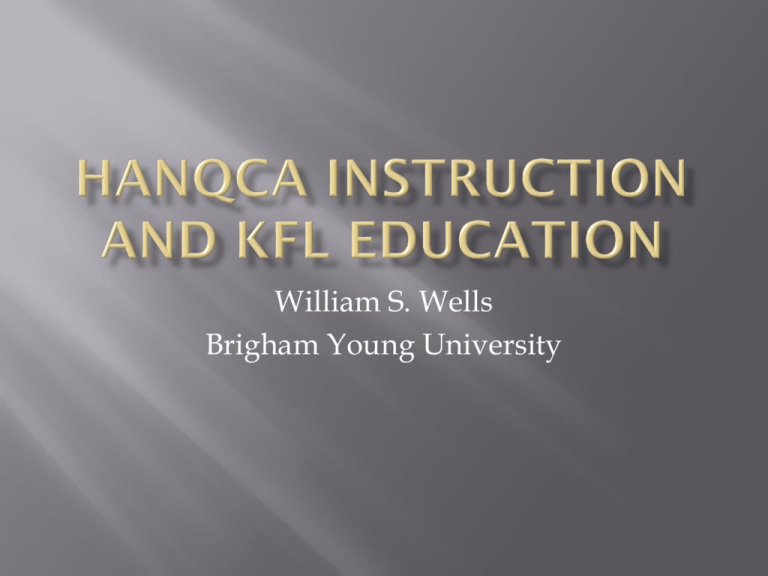hanqca instruction and kfl education
advertisement

William S. Wells Brigham Young University KFL – Korean as a Foreign Language for native English speakers. Hanqca – Sino-Korean Characters, or individual Chinese characters as may be used in a text of Korean Language to express words of Chinese origin. Sino-Korean Vocabulary – 1) vocabulary historically Chinese in origin borrowed into Korean, 2) as well as new words coined by Koreans using Chinese roots or morphemes. Sino-Korean vocabulary comprises 60 – 70 percent of all Korean words. These words can be and often are expressed in written form using hanqca, especially to disambiguate homophones, despite the fact that the words are amply expressed using the native Korean script hankul. The study and use of hanqca has historically played a significant role in the education of the Korean literate class. Korean middle and high school students today are required to learn 1800 hanqca. What does this mean for the place of hanqca instruction in the KFL classroom? That is, does it belong? Hanqca is purely an orthographic phenomenon and has little to no practical pedagogical function in a KFL classroom. With hanqca being almost completely dropped from newly published Korean texts, hanqca instruction, especially at the beginning level, is needless and anachronistic in a modern language classroom where emphasis should be first and foremost on oral performance. Hanqca instruction is a long cherished method for studying the roots of Sino-Korean loan words. It is an effective tool for language learning that helps students acquire loans quickly. Because it is an aid to vocabulary acquisition it should be incorporated into the KFL classroom, even at the beginning level. If incorporated into a KFL curriculum does hanqca instruction increase students’ acquisition of SinoKorean vocabulary? If not, we may argue for the exclusion of hanqca from KFL programs except as merely an interesting historical or orthographic phenomenon. If such instruction does improve Sino-Korean vocabulary acquisition, however, it is worth serious consideration as an essential pedagogical tool of KFL from beginning levels. Over a period of two semesters all students taking BYU’s KOREA 301 were offered a semester long two-credit hour course in hanqca instruction. The course was not mandatory and students signed up on a volunteer basis. Those participating in hanqca instruction were taken as a test sample while non-participants served as a control sample. In all, 45 students were tested—the control group comprising 32 students with the remaining 13 student-volunteers comprising the test group. During this period all KOREA 301 students were administered Sino-Korean vocabulary tests during the first and last week of the course. The pre- and post-tests were identical in format but contained different test words. The tests consisted of six sections of 20 questions each. In each section half the questions included hanqca in parenthesis next to the word being tested while half included no hanqca. Control group Pre-test: 53% correct Post-test: 59% correct Increase: 11.3% Test group Pre-test: 48% Post-test: 69% Increase: 43.8% Can the difference in test scores be attributed to the test group’s two extra class hours per week? What about extra Korean class hours by the control group? What about Word List vocabulary? Does the method of hanqca instruction make a difference? If introduced at the beginning level, what amount extent is appropriate? Does the learner’s level determine what instruction paradigm is most effect, or does one paradigm work for all levels?




